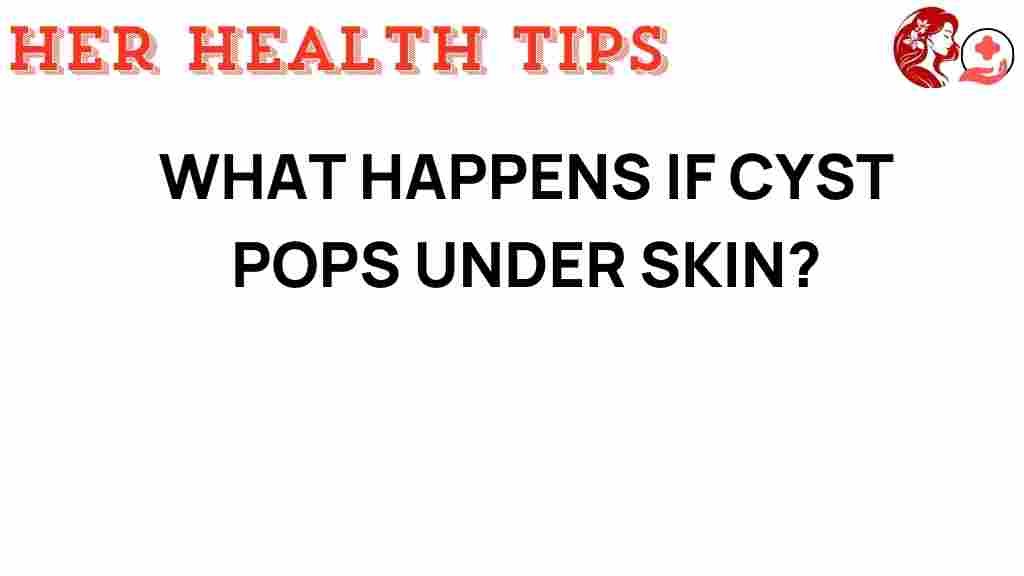Unveiling the Mystery: What Really Happens When a Cyst Pops Under Your Skin?
Cysts are common skin conditions that can occur anywhere on the body. They are typically filled with fluid, air, or semi-solid material and can vary in size. When a cyst pops under your skin, it can lead to a range of symptoms and potential complications. Understanding what happens during this process is crucial for maintaining skin health and knowing when to seek medical advice. In this article, we will explore the nature of cysts, the symptoms associated with them, treatment options, and important self-care tips.
What is a Cyst?
A cyst is a closed sac-like structure that forms in tissue. While they can develop in various areas of the body, including the skin, they are most commonly found in the following forms:
- Epidermoid Cysts: These are the most common type of skin cysts, often arising from clogged hair follicles or skin trauma.
- Pilar Cysts: Typically found on the scalp, these cysts originate from hair follicles and are usually firm and movable.
- Sebaceous Cysts: Often mistaken for epidermoid cysts, these are actually blocked sebaceous glands and can become inflamed or infected.
Symptoms of a Cyst
Symptoms of a cyst can vary depending on its location, size, and whether it has become inflamed or infected. Common symptoms include:
- Visible bump or lump on the skin
- Redness and swelling in the surrounding area
- Pain or tenderness upon touch
- Drainage of fluid or pus if the cyst ruptures
What Happens When a Cyst Pops?
When a cyst pops under your skin, a series of events occur that can impact your skin health. Here’s a step-by-step process of what happens:
Step 1: Rupture of the Cyst
The first stage is the rupture of the cyst wall. This can happen due to pressure from the surrounding tissues, friction, or even manual squeezing. Once the cyst wall breaks, the contents spill out into the surrounding tissue.
Step 2: Inflammatory Response
The body reacts to the sudden release of cyst contents through an inflammatory response. The immune system sends white blood cells to the area, which can lead to:
- Redness and swelling
- Pain and tenderness
- Increased warmth in the affected area
Step 3: Risk of Infection
When a cyst pops, there is an increased risk of infection. The contents of the cyst may contain bacteria, which can lead to:
- Infection of the surrounding skin (cellulitis)
- Formation of an abscess
If you notice pus, increased pain, or fever after a cyst pops, it’s important to seek medical advice promptly.
Treatment Options for Cysts
Treatment for a cyst that has popped will depend on the severity of the symptoms and any complications that may arise. Here are some common treatment options:
1. Home Care
For minor cases, self-care can be effective:
- Keep the area clean: Gently wash the area with soap and water.
- Apply a warm compress: This can help reduce inflammation and promote drainage.
- Avoid squeezing: Do not attempt to squeeze the cyst, as this can worsen inflammation or lead to infection.
2. Medical Treatment
If symptoms persist or worsen, medical treatment may be necessary:
- Drainage: A healthcare professional can drain the cyst and remove any debris.
- Antibiotics: If infection is present, antibiotics may be prescribed.
- Injection of steroids: To reduce inflammation, a doctor may inject steroids into the area.
3. Surgical Removal
In cases where cysts recur or become problematic, surgical removal may be recommended. This procedure allows for complete removal of the cyst wall, minimizing the chance of recurrence.
Inflammation and Infection: When to Seek Medical Advice
It’s essential to monitor the symptoms following a cyst rupture. Seek medical advice if you experience:
- Severe pain or discomfort
- Fever or chills
- Redness and swelling that worsens
- Pus or drainage that has an unpleasant odor
Common Complications
Complications from a popped cyst can include:
- Persistent inflammation: If the body continues to react to the contents of the cyst.
- Infection: As mentioned, bacteria can enter the body through the rupture.
- Scarring: Depending on the cyst’s location and treatment, scarring may occur.
Self-Care Tips for Skin Health
Maintaining skin health is critical, especially if you have experienced cysts in the past. Here are some self-care tips:
- Keep your skin clean: Regular cleansing can prevent clogged pores that lead to cysts.
- Moisturize: Use a gentle moisturizer to keep your skin hydrated.
- Avoid picking at your skin: This can lead to infection and scarring.
- Monitor changes: Keep an eye on any new lumps or changes in existing cysts.
When to Visit a Dermatologist
If you frequently experience cysts or have concerns about your skin, consider scheduling an appointment with a dermatologist. They can provide tailored medical advice and treatment options. For more information on dermatology services, visit this resource.
Conclusion
Understanding what happens when a cyst pops under your skin can help you manage your skin health effectively. While cysts are generally benign, they can lead to inflammation, infection, and other complications if not treated properly. Always prioritize self-care and seek medical advice when necessary to avoid complications. Remember, your skin is a vital part of your overall health, and taking care of it is essential.
For more tips on skin health and dermatology, check out our other articles here.
This article is in the category Conditions and created by HerHealthTips Team
